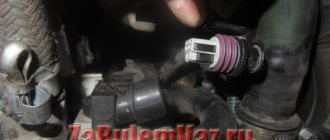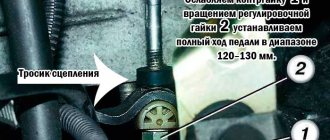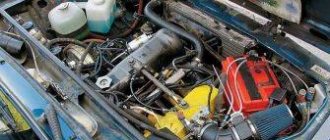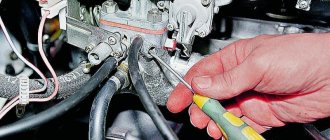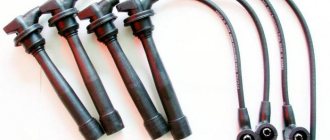Carburetor structure VAZ 2107, VAZ 2105, VAZ 2104, Lada Zhiguli, Classic
Diagram of the main dosing system of the carburetor VAZ 2104, VAZ 2105, VAZ 2107 and econostat (the econostat spray is located in the second chamber of the carburetor. In the diagram it is conventionally shown in the first chamber): 1 - emulsion jet of the econostat; 2 — emulsion channel of the econostat; 3 — air jet of the main dosing system; 4 — econostat air jet; 5 — econostat fuel jet; 6 — needle valve; 7 — float axis; 8 — locking needle ball; 9 — float; 10 - float chamber; 11 — main fuel jet; 12 - emulsion well; 13 - emulsion tube; 14 — axis of the throttle valve of the first chamber; 15 — spool groove; 16 — spool; 17 — large diffuser; 18 — small diffuser; 19 – sprayer
Diagram of the carburetor idle system for VAZ 2104, VAZ 2105, VAZ 2107: 1 - throttle body; 2 — throttle valve of the first chamber; 3 - holes for transition modes; 4 - adjustable hole; 5 — air supply channel; 6 – economizer needle; 7 — forced idle economizer housing; 8 — economizer cover; 9 — hose connecting the economizer to the pneumatic valve; 10 — adjusting screw for the amount of mixture; 11 — adjusting screw for the composition (quality) of the mixture; 12 — emulsion channel of the idle system; 13 — carburetor body cover; 14 — air damper; 15 — air jet of the idle system; 16 — fuel jet of the idle system; 17 — fuel channel of the idle system; 18 - emulsion well; 19 — pneumatic valve; 20 - hose going to the inlet pipe
Diagram of the drive of the throttle valves of the Lada classic carburetor: 1 - pneumatic drive nozzle located in the diffuser of the first chamber; 2 — throttle valve drive lever; 3 - lever rigidly connected to the axis of the throttle valve of the first chamber; 4 - lever limiting the opening of the throttle valve of the second chamber; 5 — pneumatic drive jet located in the diffuser of the second chamber; 6 - lever connected to lever 9 through a spring; 7 — axis of the throttle valve of the second chamber; 8 — pneumatic drive rod; 9 — throttle control lever of the second chamber; 10 — channel for supplying vacuum to the pneumatic drive; 11 — rod bushing; 12 — pneumatic drive of the throttle valve of the second chamber
Diagram of the carburetor starting device for VAZ 2104, VAZ 2105, VAZ 2107: 1 - choke control lever; 2 – air damper; 3 — air pipe of the first chamber; 4 - traction; 5 — starting rod; 6 - diaphragm; 7 - adjusting screw; 8 - cavity communicating with the throttle space; 9 — telescopic rod; 10 — throttle valve drive lever; 11 - sector (antenna); 12 — axis of the throttle valve of the first chamber; 13 — lever on the axis of the throttle valve of the first chamber; 14 - lever connected to the air damper
Diagram of the accelerator pump of the carburetor VAZ 2104: 1 - screw valve; 2 - spray; 3 - fuel channel; 4 - bypass jet; 5 - float chamber; 6 — accelerator pump drive sector; 7 — drive lever; 8 — return spring; 9 — diaphragm cup; 10 — pump diaphragm; 11 — inlet ball valve; 12 — pump vapor chamber
The VAZ-2107 car is equipped with an emulsion-type carburetor, two-chamber, with a falling flow. It has a balanced float chamber, two main metering systems, an enrichment device (econostat) with a pneumatic drive, a crankcase gas suction system behind the throttle valve, a pipe for supplying vacuum to the vacuum ignition timing regulator of the ignition distributor, an autonomous idle system with an electronically controlled forced idle economizer by engine crankshaft rotation speed. The throttle valve of the first chamber is opened from the carburetor control pedal inside the car, and the throttle valve of the second chamber is opened from a pneumatic drive. The choke has a diaphragm trigger for starting a cold engine. A mechanically driven diaphragm-type accelerator pump supplies fuel to the first chamber. The carburetor is mounted on four studs in the intake manifold. Carburetor calibration data.
Adjusting the engine idle speed
NOTE: Blue bushings are installed at the factory, and red bushings are installed at service stations.
Screws for adjusting the idle speed system of the VAZ 2105 carburetor: 1 - mixture quantity screw; 2 - mixture quality screw
The idle speed adjustment of the VAZ 2104, VAZ 2105, and VAZ 2107 engines is carried out by screw 2, which determines the composition of the mixture, and screw 1, which controls the amount of the mixture. To ensure that the car owner does not violate the factory settings, restrictive plastic bushings are pressed onto the screws, allowing the screws to be turned only half a turn. If it is not possible to adjust the CO content in the exhaust gases with the bushings, then by unscrewing the screws, break the heads of the bushings, unscrew the screws, remove the bushings from them and screw the screws back into the carburetor. The idle speed adjustment of the VAZ 2107 is carried out on a warm engine (coolant temperature 90–95°C and oil temperature 75–90°C) with adjusted clearances in the gas distribution mechanism and with a correctly adjusted ignition timing.
Make adjustments in the following order:
— using screw 1, set the crankshaft rotation speed to 820–900 min-1 according to the stand’s tachometer, — using screw 2, achieve the concentration* of CO in the exhaust gases within 0.5–1.2% at this position of screw 1; — use screw 1 to restore the crankshaft speed to 820–900 min-1, — if necessary, use screw 2 to restore the CO concentration to 0.5–1.2%;
Briefly about the features and structure of the “six” carburetor unit
Before adjusting the carburetor on a VAZ 2106, it doesn’t hurt to know its design features. After 1980, Ozone and Solex began to be installed on Tolyatti cars. The purpose of the unit’s operation is to prepare a combustible mixture before feeding it into the car’s cylinders. Down to the subtleties, this is not a driving school, we will not disassemble the design, it is enough to familiarize yourself with the main components that ensure optimal operation of a carburetor internal combustion engine:
- Fuel dosing system.
- Mechanisms for controlling throttle valves and enriching the mixture.
- Idle system.
- Accelerator pump and econostat.
- Float chamber.
A chamber with a float and a needle valve is responsible for the stability of the fuel level. Next, gasoline, flowing through the spray tube, enters the chamber, where it mixes with air from the inlet pipe. The amount of mixture is adjusted by the throttle valve, which is connected to the accelerator pedal.
Precise adjustment allows you to prepare the correct mixture of gasoline and air in a ratio of 1:15. During long-term operation of the car, the settings get lost and you have to think about how to adjust the carburetor on a VAZ 2106 on your own. The adjustment technology is the same for both Solex and Ozone.
Nuances of the VAZ-2105 carburetor adjustment process
Experts immediately warn inexperienced car enthusiasts: if you don’t know where the carburetor is located in the car and what it consists of, then you shouldn’t even start adjusting. By incorrectly changing the parameters of the fuel system, the entire vehicle can be damaged. It is best to entrust this procedure to qualified auto mechanics from a service station.
So, to begin adjusting the carburetor of a certain vehicle model, you need to study its structure. Thus, the VAZ-2105 carburetor contains several important systems:
- dosing;
- starting and warming up the engine;
- maintaining an optimal level of fuel fluid;
- starting idle;
- econostat system;
- accelerator pump.
Three of all the listed systems are subject to standard adjustment:
- Starting and warming up the internal combustion engine (the starting device is configured).
- Maintaining the fuel fluid level (the float mechanism is adjusted).
- Idle speed (speed calibration is performed using a specific screw).
To set them up, it is absolutely not necessary to remove the carburetor device from the car.
What do we have after proper adjustment of the carburetor unit of the “six”?
Checking the adjustments of the fuel mixture preparation unit is the same important maintenance step as monitoring the condition of the car battery . An integrated approach to setting up the carburetor guarantees not only a comfortable mode of movement, but also a lot of useful points:
- An increase in power and a confident increase in speed.
- No failures in the operation of the internal combustion engine in the low and medium speed sector.
- Improved dynamic characteristics - the car picks up speed faster and accelerates in a short time.
- Optimal engine response, which is expressed in the responsiveness of the gas pedal.
The listed qualities make it possible to effectively use the combustible mixture, which is necessary both in urban traffic jams and on country roads. Therefore, proper adjustment of the carburetor unit will help the car gain speed in a timely manner and complete the planned maneuver.
The carburetor on any vehicle is one of the components of the fuel system of an internal combustion engine. It mixes air with fuel liquid, and this mixture is supplied to the cylinders of the internal combustion engine. As you can see, this automotive part plays a very important role in the functioning of the vehicle as a whole. Therefore, the carburetor must be adjusted periodically. You will learn how to do this correctly on a VAZ-2105 from this article.
The first stage is setting up the float mechanism of the VAZ-2105 carburetor
First of all, to adjust the carburetor float mechanism, the car should be allowed to idle. And only after that begin the adjustment procedure.
- The carburetor cover is removed.
- The current level of fuel fluid in the chamber of the float mechanism is checked (its digital indicator should ideally be 28 mm).
If the digital indicator of the fuel level in the float chamber corresponds to the norm, then nothing needs to be adjusted. Otherwise, you need to do the following:
- check the distance from the cover gasket and the float itself (this is done at the moment the needle valve ball comes into contact with it) - the norm is 6.5 mm (+- 0.25 mm);
- bend the tongue;
- check the maximum stroke of the valve needle - the norm is 8 mm;
- check the distance from the cover gasket to the maximum retracted float - the norm is 14 mm (+- 0.5 mm).
If the indicators do not meet standard standards, they can be adjusted using a bracket. If the optimal level of fuel fluid in the float chamber was not obtained after adjustment, the needle valve will have to be replaced.
The second stage - we adjust the starting device of the VAZ-2105 carburetor
At this stage, in a garage environment, a car enthusiast can perform the following steps to configure the carburetor system that starts and warms up the engine:
- close the air damper (this is done using the thrust handle located in the car interior);
- check the location of the rod shank, which must be at the end of the groove of the carburetor rod to start the system;
- measure the gap level from the edge of the valve to the chamber wall (measurements are taken when the rod is recessed) - the norm is 5-5.5 mm.
If the digital indicators differ from the established standards, they are adjusted by rotating a special adjusting screw (it is located on the carburetor trigger).
Third stage - idle speed adjustment
This stage is no less important than the previous two. To do this, the internal combustion engine is pre-started and warmed up. Only after this can the idle speed be adjusted.
- The motor is brought out using rotational movements of the mixture quantity screw - the norm is 850 rpm:
- to increase the speed, you need to rotate the mixture quality screw (to the maximum level);
- to reduce the speed you need to rotate the quantity screw (to the desired level of 850).
- Tighten the quality screw as far as it will go (rotational movements are performed until the motor stops shaking).
- Unscrew the same screw in the opposite direction three turns.
Expert advice
After completing the procedure for adjusting the VAZ-2105 carburetor device, experienced auto mechanics recommend paying attention to the following critical points:
- Valve location - is in the retracted position, with the idle speed jet touching the seat in the carburetor body.
- Lubricating the rubber seal with special motor oil.
- The location of the air damper intended for cold passage is in a vertical plane, while the suction handle is lowered.
- The condition of the solenoid valve - the presence of damage and malfunctions is checked as follows:
- turn on the ignition;
- remove and put the connector on the valve;
- listen to the sounds coming from the solenoid valve.
If clicks are heard during the inspection process, the part is in full working order.
Oil type
We looked at what kind of oil to pour into a VAZ 2110 in winter based on such a parameter as viscosity.
But the type of lubricant should also be taken into account. There are three in total:
- Mineral;
- Synthetic;
- Semi-synthetic;
Mineral oil for winter VAZ-2109 is the worst option. Such a lubricant made by processing petroleum products is characterized by insufficiently good performance indicators, especially low-temperature viscosity. That is, its thickening threshold is much higher than that of other types of oil. But here it is worth noting that such oil for use as a lubricant is practically never found. But it is often used as a basis for flushing liquids.
Synthetic oil is one of the most optimal options for power plants of modern cars. It is obtained by synthesis, during which certain parameters of the lubricant are set, including viscosity. Therefore, when deciding which oil to pour into a VAZ-2114 in winter, preference should be given to synthetic oil.
It is these two criteria - viscosity and type that should be taken into account when determining which oil to fill in the VAZ-2115 or any other model for the winter.
Naturally, you should pay attention to the manufacturer. You should not buy lubricant from dubious places of sale or from little-known manufacturers. When choosing oil, it is better not to skimp.
When choosing oil, it is better not to skimp.
Adjusting the idle speed of a car engine with carburetors 2105, 2107 Ozone
Adjusting the idle speed of carburetors 2105, 2107 Ozone and their modifications is one of the most frequently performed operations in carburetor maintenance. As a result, it is necessary to achieve stable engine operation at a crankshaft speed of 850-900 rpm, as well as to normalize the content of CO and CH in the exhaust gases.
Tools required for adjusting XX speed
— tachometer (you can use the one built into the instrument panel) — slotted screwdriver (3 mm) If you don’t have a tachometer, you can adjust the idle speed by ear. But for this you must have at least some experience in car repair, since it is necessary to distinguish when the speed is normal and when it is increased or decreased.
Preparatory work
Before making adjustments, you must first make sure that the ignition timing is set correctly. The distributor cover, breaker contacts, armored wire and spark plugs are in good condition.
If the carburetor is after disassembly and reassembly or you simply need to set the initial value of the adjustment screws, then first tighten them completely, and then turn out the “quality” screw by 2-3 turns, and the “quantity” screw by 3-4.
— Warm up the engine to operating temperature (85-95 ). — With the engine stopped, connect the tachometer and start it again.
procedure for connecting an autotester (tachometer)
Adjusting the idle speed of an engine with a carburetor 2105, 2107 Ozone We carry out the adjustment in four stages.
1. Turn the “quality” screw and set the maximum idle speed.
Rotate the screw counterclockwise.
turn the “quality” screw of the fuel mixture of the carburetor 2105, 2107 Ozone counterclockwise, thereby increasing the supply of gasoline to the fuel-air mixture
2. Use the “quantity” screw to set an even higher rotation speed. For example, 80 rpm more. Rotate the screw counterclockwise.
rotate the “amount” screw of the fuel mixture counterclockwise, increasing the total amount of fuel mixture entering the engine cylinders
3. We check with the “quality” screw whether these revolutions are the maximum for the given position of the “quantity” screw.
Simply rotating it back and forth.
We check by rotating the “quality” screw in different directions whether the set idle speed is maximum
If not, then we carry out the above adjustments again.
4. Keeping the position of the “quantity” screw of the fuel mixture unchanged, tighten the “quality” screw so much that the speed drops to 850-900 rpm.
Adjustment in this way is very simple, but at the same time convenient, since it does not require special equipment.
If, after such an adjustment, the content of CO and CH emissions does not correspond to the norm or the idle speed cannot be adjusted, then it is necessary to check:
— whether the fuel and air jets of the main dosing system are dirty; — whether the main fuel jets of the first and second chambers are reversed; — whether the fuel level in the float chamber is increased; — Is the needle valve working? - Is the fuel jet of the idle system clogged; — whether the holder of the fuel jet of the idle system or the solenoid valve has turned away; — whether the tubes have come off the electro-pneumatic valve; — whether the rubber o-ring on the fuel mixture “quality” screw is damaged.
— In some cases, it makes sense to modify the carburetor idle system. See “Modification of the idle system of Solex and Ozone carburetors.”
Five more articles on the site on adjusting and tuning carburetors 2105, 2107 Ozone
Write a review
Your feedback:
Attention: HTML is not supported! Use plain text. Grade:
Grade:
Bad Good
Enter the code shown in the picture:
Question: Is this an original DAAZ carburetor, not a fake?
Answer: The carburetors are original.
Carburetors from other manufacturers are often mistaken for fakes: AT, LSA, Road Map, PEKAR
These manufacturers have their own markings and appearance.
We have no information about cases of counterfeit carburetors of the main models produced by OJSC DAAZ. There is no protection on the carburetors either. It is better to make the purchase in the presence of an experienced motorist, who will be able to determine by appearance that the product is counterfeit. Start your purchase by inspecting the carburetor packaging.
Boxes for packaging carburetors are universal, with designations of carburetors that can be packed in them. A mark is made against the designation of the carburetor actually packed in the box, usually in the form of a tick.
All distinctive features, markings, appearance, etc. You can watch the video review on the product page
Question: What color is the box?
Answer: Carburetors come in boxes from LADA Image JSC and OAT Group
Packaging design of JSC "LADA Image":
Packaging design "Group OAT":
Question: There is a version that the original DAAZ products are packaged only in a red and white box, and everything else is fake.
Answer: The official website already has answers to similar questions. You can also find tips and tricks on setting up carburetors there.
Answer:
Answer:
Answer:
1) Why increase the speed much higher than recommended by the car manual?
2) When changing the idle mode only due to one adjusting element, inevitably, the mixture composition will go beyond the optimal range and unstable speed will appear.
Answer:
Question: I have a SOLEKS 21053 carburetor, should the float chamber needle keep the fuel flow if the return line is plugged? Answer: The float and needle valve are capable of maintaining a constant fuel level up to a pressure of 0.45 kg/cm2.
Question: I bought a carburetor 21053-1107010-20 for a VAZ-21053, and there are three vacuum distributor fittings. Which of these fittings (upper, lower or middle) should it be connected to, and what are the two additional fittings for? Answer: The lower fitting is intended for connecting the vacuum ignition timing corrector on the distributor-distributor. The two upper fittings should be plugged, because they are designed to control the exhaust gas recirculation valve, which your vehicle does not have.
Question: I read most of the “questions and answers”, but did not find an answer to my question. Which jets need to be changed on Solex 21053-1107010-20 for a 1.2l engine?
Answer: For a 1.2 liter engine. You need a carburetor 21051-107010 (currently not produced due to lack of demand) with 23x23 diffusers. On the carburetor 21051-1107010-20, you should install the fuel jet GDS 1 chamber 102.5 or 105, if there are comments on your fuel consumption.
Question: I have several questions about carburetors. 1. When installing a 21053 carburetor on a classic, what kind of textolite gasket should be used, thin or thick, between the carb and the intake manifold, and what will result from an incorrect installation (now the thick one seems to be from 8, but in your FAK I saw a message that you need to install 4mm) . 2. I have an engine displacement of 1650, compression 13-14, is carburetor 21053 suitable? Or is it better to put Ozone? 3. I was interested in why the second chamber in carburetor 21053 is very lean? (110/165) no other has such depletion, what is this connected with and wouldn’t it be better to put at least 115/165? 4.How does the level in the float chamber affect the flow rate? If it is less, then the consumption is also less and vice versa? How to correctly set the floats, in the literature there is a template according to which the level is set and at the same time it is said that from the gasket to the floats when the ball is pressed there should be 2mm and this somewhat contradicts the template. Why am I asking all this, I just found out experimentally that the jets in the first chamber exactly correspond to the factory ones (107.5/145 (slightly leaner)), but I haven’t really picked up the 2nd chamber yet... the dynamics are generally satisfactory, but the fuel consumption is slightly increased, sometimes 15l/ 100 km in the city, maybe it’s worth putting Ozone on my volume?
Adjusting the VAZ-2105 carburetor - how is it done?
The process of adjusting the VAZ-2105 carburetor is a simple task that can be completed by any car owner who knows the structure and the sequence of necessary operations. The principle of operation of a carburetor is to create a fuel-air mixture by mixing gasoline with oxygen and then feeding it into the combustion chamber. In this article we will get acquainted with the design, features and advantages, and also take a detailed look at how to adjust this unit with your own hands.
Main parts
To perform its tasks, the carburetor
VAZ
2105 consists of the following mechanisms and systems:
See:
- Engine starting and warming up system.
- System for maintaining the required fuel level .
- System XX (idle);
- Econostat system.
- Acceleration pump.
- Main dosing system.
There are three systems that can be configured - they are first on the list. Adjusting the VAZ carburetor 2105
can be performed without removing the device from the machine.
How to adjust the carburetor on a UAZ. Due to the fact that the carburetors of the fifth and seventh models are identical in structure and differ only in the diameters of the holes of the air and fuel jets, the carburetor for the VAZ 2107 can be adjusted using the same method.
Stages of setting up a VAZ 2015 carburetor
Without knowing the design of the car and without any experience in repairing, disassembling or assembling the fuel system of a car, it is not recommended to make adjustments. Changing the settings incorrectly may worsen the problem or damage the device. If you are familiar with the design of your car's carburetor, adjusting it will not be difficult. Adjusting the 2105 carburetor can significantly improve vehicle efficiency, reduce fuel consumption and increase the performance of the power unit. These so-called performance upgrades do not have any detrimental effect on the device. On the contrary, they are a mandatory procedure that guarantees long, uninterrupted operation.
Screws for adjusting the idle speed system of the VAZ 2105 carburetor: 1 - mixture quantity screw; 2 - mixture quality screw
Crankshaft speed calibration . The first thing to do is change the speed to 750-800 units per minute. To perform this procedure, a quantity adjustment screw is provided. It must be screwed all the way, and then unscrewed three times in the opposite direction.
Change in CO2 content . We regulate the amount of carbon dioxide in the exhaust using the quality screw. To do this, you need to screw the screw in until it stops, and then unscrew it back 4-5 turns. This will increase the concentration of fuel and richen the mixture.
Warming up the engine is a mandatory procedure, without which you cannot proceed to the next stages of work.
Speed adjustment . Using the quantity screw, we adjust the idle speed. It is necessary to achieve stable operation of the motor at 750-800 rpm. Gradually tightening the quality screw. During this process, the speed should increase slightly and then decrease, causing the engine to run erratically. After unstable operation of the power unit begins, we begin to screw the screw back in until the operation of the motor stabilizes.
Setting XX . Finally, you need to calibrate the idle speed using the appropriate screw to 800-900 units.
After completing all stages of adjustment and achieving the required parameters, you need to test the carburetor. With the engine running, sharply press the accelerator pedal and release it. If adjusted correctly, the crankshaft speed will temporarily increase. If the engine stalls, increase the speed using the appropriate adjusting screw. Check the operation of the motor at full load by turning on the stove, lights, etc.
Video - How to set up a VAZ 2105 carburetor
Useful tips
- Valve position . It must be pushed in so that the idle jet touches its connector (seat) in the device body. To do this, it is recommended to lubricate the rubber seal with engine oil.
- Cold pass system air damper position, with the choke handle lowered, must be in a strictly vertical plane.
- When the quality adjustment screw is screwed in all the way, the engine should stall . If this does not happen, the reason may be incorrect adjustment of the VAZ-2105 carburetor. Using the appropriate bolts, you need to change the speed up.
- Vacuum in the tube between the carburetor and the ignition distributor . When the engine is idling, there should be no vacuum in the vacuum tube. The reason for its occurrence may be a tightly tightened locking screw of the throttle valve. Adjustment of this element is carried out using a locking screw. In the correct position, the damper does not jam in the diffuser and provides sufficient tightness. When 2-3 cm 3 of fuel is poured into the chamber, it should not noticeably leak through the valve. When you press the gas pedal, it moves smoothly without jerking. An identical method is used to test and adjust the damper on the second chamber, with the exception of the tube, which is only in the first chamber.
- Solenoid valve. In carburetors designed for engines with a displacement of 1500 cm 3 or more, in place of the holder of a conventional fuel jet there may be an electromagnetic valve with an XX jet. If it is included in the design of the device in question, it is necessary to check its functionality and ensure the integrity of the electromechanical element. With the ignition on, you need to remove and put the connector on the valve. The occurrence of clicks during these operations will indicate the serviceability of the part being tested.
- For the summer season, it is recommended to reduce the idle speed to 800-900 units, and in winter to increase it to 900-1000 rpm . This setting will improve the efficiency of the power unit taking into account climatic conditions.
